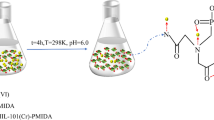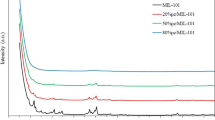Abstract
The metal-organic framework (MOF) materials, MIL-101(Cr), and copper-doped MIL-101(Cr) (Cu@MIL-101(Cr)) were prepared through hydrothermal method and were used to remove volatile organic compounds (VOCs) in this study. Morphological characterization demonstrated that MIL-101(Cr) and Cu-3@MIL-101(Cr) were octahedral crystal, with specific surface area of 3367 and 2518 m2/g, respectively. The results of XRD, TG, and FTIR showed that the copper doping procedure would not alter the skeleton structure, but it would affect the crystallinity and thermal stability of MIL-101(Cr). Besides, MIL-101(Cr) and Cu-3@MIL-101(Cr) displayed good removal efficiencies on benzene sorption, and the maximum sorption capacity was 103.4 and 114.4 mg/g, respectively. In competitive adsorptions, the order of adsorption priority on Cu-3@MIL-101(Cr) was as follows: ethylbenzene > toluene > benzene. Hence, it could be concluded that MIL-101(Cr) and copper-doped MIL-101(Cr) demonstrated good performance in VOCs adsorption and showed a promising potential for large-scale applications in the removal of VOCs.

ᅟ









Similar content being viewed by others
References
Ahmed I, Jhung SH (2014) Composites of metal-organic frameworks: preparation and application in adsorption. Mater Today 17:136–146
Awadallah-F A, Elkhatat AM, Al-Muhtaseb SA (2011) Impact of synthesis conditions on meso-and macropore structures of resorcinol-formaldehyde xerogels. J Mater Sci 46:7760–7769
Bloch ED, Britt D, Lee C, Doonan CJ, Uribe-Romo FJ, Furukawa H, Long JR, Yaghi OM (2010) Metal insertion in a microporous metal-organic framework lined with 2,2’-Bipyridine. J Am Chem Soc 132:14382–14384
Britt D, Tranchemontagne D, Yaghi OM (2008) Metal-organic frameworks with high capacity and selectivity for harmful gases. P Natl Acad Sci USA 105:11623–11627
Carson F, Su J, Plateroprats AE, Wan W, Yun Y, Samain L, Zou X (2013) Framework isomerism in vanadium metal-organic frameworks: MIL-88B(V) and MIL-101(V). Cryst Growth Des 13:5036–5044
Chen H, Chen S, Yuan X, Zhang Y (2013) Facile synthesis of metal-organic framework MIL-101 from 4-NIm-Cr (NO3)3-H2 BDC-H2O. Mater Lett 100:230–232
Chen YZ, Xu Q, Yu SH, Jiang HL (2015) Tiny Pd@co Core-Shell nanoparticles confined inside a metal-organic framework for highly efficient catalysis. Small 11:71-76
Chowdhury P, Bikkina C, Gumma S (2009) Gas adsorption properties of the chromium-based metal organic framework MIL-101. J Phys Chem C 113:6616–6621
Darunte LA, Oetomo AD, Walton KS, Sholl DS, Jones CW (2016) Direct air capture of CO2 using amine functionalized MIL-101 (Cr). ACS Sustain Chem Eng 4:5761–5768
Dincă M, Long JR (2008) Hydrogen storage in microporous metal-organic frameworks with exposed metal sites. Angew Chem Int Edit 47:6766–6779
Durmusoglu E, Taspinar F, Karademir A (2009) Health risk assessment of BTEX emissions in the landfill environment. J Hazard Mater 176:870–877
Férey G, Mellot-Draznieks C, Serre C, Millange F, Dutour J, Surblé S, Margiolaki I (2005) A chromium terephthalate-based solid with unusually large pore volumes and surface area. Science 309:2040–2042
Finsy V, Verelst H, Alaerts L, De Vos D, Jacobs PA, Baron GV, Denayer JF (2008) Pore-filling-dependent selectivity effects in the vapor-phase separation of xylene isomers on the metal−organic framework MIL-47. J Am Chem Soc 130:7110–7118
Freundlich H (1906) Over the adsorption in solution. J Phys Chem 57:1100–1107
Ge F, Li MM, Ye H, Zhao BX (2012) Effective removal of heavy metal ions Cd2+, Zn2+, Pb2+, Cu2+ from aqueous solution by polymer-modified magnetic nanoparticles. J Hazard Mater 211:366–372
Gu ZY, Jiang DQ, Wang HF, Cui XY, Yan XP (2009) Adsorption and separation of xylene isomers and ethylbenzene on two Zn−terephthalate metal−organic frameworks. J Phys Chem C 114:311–316
Gu ZY, Yan XP (2010) Metal-organic framework MIL-101 for high-resolution gas-chromatographic separation of xylene isomers and ethylbenzene. Angew Chem Int Edit 49:1477–1480
Gwilherm E, Nicolas B, Mathieu T (2008) Copper-mediated coupling reactions and their applications in natural products and designed biomolecules synthesis. Chem Rev 108:3054–3131
Hasan Z, Jhung SH (2015) Removal of hazardous organics from water using metal-organic frameworks (MOFs): plausible mechanisms for selective adsorptions. J Hazard Mater 283:329–339
He C, Lu K, Liu D, Lin W (2014) Nanoscale metal-organic frameworks for the co-delivery of cisplatin and pooled siRNAs to enhance therapeutic efficacy in drug-resistant ovarian Cancer cells. J Am Chem Soc 136:5181–5184
Hong DY, Hwang YK, Serre C, Férey G, Chang JS (2009) Porous chromium terephthalate MIL-101 with Coordinatively unsaturated sites: surface functionalization, encapsulation, sorption and catalysis. Adv Funct Mater 19:1537–1552
Hoskins BF, Robson R (1989) Infinite polymeric frameworks consisting of three dimensionally linked rod-like segments. J Am Chem Soc 111:5962–5964
Huang CY, Song M, Gu ZY, Wang HF, Yan XP (2011) Probing the adsorption characteristic of metal-organic framework MIL-101 for volatile organic compounds by quartz crystal microbalance. Environ Sci Technol 45:4490–4496
Jhung SH, Lee JH, Yoon JW, Serre C, Férey G, Chang JS (2007) Microwave synthesis of chromium terephthalate MIL-101 and its benzene sorption ability. Adv Mater 19:121–124
Kidwai M, Mishra NK, Bhardwaj S, Jahan A, Kumar A, Mozumdar S (2010) Cu nanoparticles in PEG: a new recyclable catalytic system for N-Arylation of amines with aryl halides. Tetrahedron Lett 2:1312–1317
Kim JH, Lee SJ, Kim MB, Lee JJ, Lee CH (2007) Sorption equilibrium and thermal regeneration of acetone and toluene vapors on an activated carbon. Ind Eng Chem Res 46:4584–4594
Kruk M, Jaroniec M (2001) Gas adsorption characterization of ordered organic-inorganic nanocomposite materials. Chem Mater 13:3169–3183
Langmuir I (1918) The adsorption of gases on plane surfaces of glass, mica and platinum. J Am Chem Soc 40:1361–1403
Li J, Fu HR, Zhang J, Zheng LS, Tao J (2015) Anionic metal-organic framework for adsorption and separation of light hydrocarbons. Inorg Chem 54:3093–3095
Lin YF, Chen HW, Chien PS, Chiou CS, Liu CC (2011) Application of bifunctional magnetic adsorbent to adsorb metal cations and anionic dyes in aqueous solution. J Hazard Mater 185:1124–1130
Liu D, Lu K, Poon C, Lin W (2013) Metal-organic frameworks as sensory materials and imaging agents. Inorg Chem 53:1916–1924
Liu J, Chen L, Cui H, Zhang J, Zhang L, Su CY (2014) Applications of metal-organic frameworks in heterogeneous supramolecular catalysis. Chem Soc Rev 43:6011–6061
Llewellyn PL, Bourrelly S, Serre C, Vimont A, Daturi M, Hamon L, de Weireld G, Chang JS, Hong DY, Kyu Hwang Y, Hwa Jhung S, Férey Ǵ (2008) High uptakes of CO2 and CH4 in mesoporous metal-organic frameworks MIL-100 and MIL-101. Langmuir 24:7245–7250
Maksimchuk NV, Timofeeva MN, Melgunov MS et al (2008) Heterogeneous selective oxidation catalysts based on coordination polymer MIL-101 and transition metal-substituted polyoxometalates. J Catal 257:315–323
Mitsudome T, Mikami Y, Ebata K, Mizugaki T, Jitsukawa K, Kaneda K (2008) Copper nanoparticles on hydrotalcite as a heterogeneous catalyst for oxidant-free dehydrogenation of alcohols. Chem Commun 39:4804–4806
Prasanth K, Rallapalli P, Raj MC, Bajaj H, Jasra RV (2011) Enhanced hydrogen sorption in single walled carbon nanotube incorporated MIL-101 composite metal-organic framework. Int J Hydrogen Energ 36:7594–7601
Rouquerol J, Rouquerol F, Llewellyn P, Maurin G, Sing KS (2013) Adsorption by powders and porous solids: principles, methodology and applications. Academic press
Santiago-Portillo A, Navalón S, Cirujano FG, Xamena FXL, Alvaro M, Garcia H (2015) MIL-101 as reusable solid catalyst for autoxidation of benzylic hydrocarbons in the absence of additional oxidizing reagents. ACS Catal 5:3216–3224
Shen L, Luo M, Liu Y, Liang R, Jing F, Wu L (2015) Noble-metal-free MoS2 co-catalyst decorated UiO-66/CdS hybrids for efficient photocatalytic H2 production. Appl Catal B Environ 166:445–453
Wang D, Zhao T, Cao Y, Yao S, Li G, Huo Q, Liu Y (2014b) High performance gas adsorption and separation of natural gas in two microporous metal-organic frameworks with ternary building units. Chem Commun 50:8648–8650
Wang XJ, Li PZ, Liu L, Zhang Q, Borah P, Wong JD, Chan XX, Rakesh G, Li Y, Zhao Y (2012) Significant gas uptake enhancement by post-exchange of zinc(II) with copper(II) within a metal-organic framework. Chem Commun 48:10286–10288
Wang Y, Xie J, Wu Y, Hu X (2014a) A magnetic metal-organic framework as a new sorbent for solid-phase extraction of copper(II), and its determination by electrothermal AAS. Microchim Acta 181:949–956
Wickenheisser M, Herbst A, Tannert R, Milow B, Janiak C (2015) Hierarchical MOF-xerogel monolith composites from embedding MIL-100 (Fe, Cr) and MIL-101 (Cr) in resorcinol-formaldehyde xerogels for water adsorption applications. Micropor Mesopor Mat 215:143–153
Yaghi OM, Li G, Li H (1995) Selective binding and removal of guests in a microporous metal-organic framework. Nature 378:703–706
Yang H (2012) Doping copper into ZIF-67 for enhancing gas uptake capacity and visible-light-driven photocatalytic degradation of organic dye. J Mater Chem 22:21849–21851
Yang K, Xue F, Sun Q, Yue R, Lin D (2013) Adsorption of volatile organic compounds by metal-organic frameworks MOF-177. J Environ Chem Eng 1:713–718
Zhang Z, Xian S, Xi H, Wang H, Li Z (2011) Improvement of CO2 adsorption on ZIF-8 crystals modified by enhancing basicity of surface. Chem Eng Sci 66:4878–4888
Zhao Z, Li X, Huang S, Xia Q, Li Z (2011a) Adsorption and diffusion of benzene on chromium-based metal organic framework MIL-101 synthesized by microwave irradiation. Ind Eng Chem Res 50:2254–2261
Zhao Z, Li X, Li Z (2011b) Adsorption equilibrium and kinetics of p-xylene on chromium-based metal organic framework MIL-101. Chem Eng J 173:150–157
Zhou W, Wu H, Yildirim T (2008) Enhanced H2 adsorption in isostructural metal-organic frameworks with open metal sites: strong dependence of the binding strength on metal ions. J Am Chem Soc 130:15268–15269
Author information
Authors and Affiliations
Corresponding authors
Additional information
Responsible editor: Tito Roberto Cadaval Jr
Highlights
The adsorption behavior and mechanism of VOCs on MIL-101(Cr) and modified MIL-101(Cr) were investigated.
The copper-doped MIL-101(Cr) showed better adsorption performance of benzene than that of the metal-free MIL-101.
Surface pore diameter and polarity of MIL-101 were important factors affecting the adsorption capacity and affinity for VOCs.
Electronic supplementary material
ESM 1
(DOCX 1731 kb)
Rights and permissions
About this article
Cite this article
Wang, D., Wu, G., Zhao, Y. et al. Study on the copper(II)-doped MIL-101(Cr) and its performance in VOCs adsorption. Environ Sci Pollut Res 25, 28109–28119 (2018). https://doi.org/10.1007/s11356-018-2849-6
Received:
Accepted:
Published:
Issue Date:
DOI: https://doi.org/10.1007/s11356-018-2849-6




